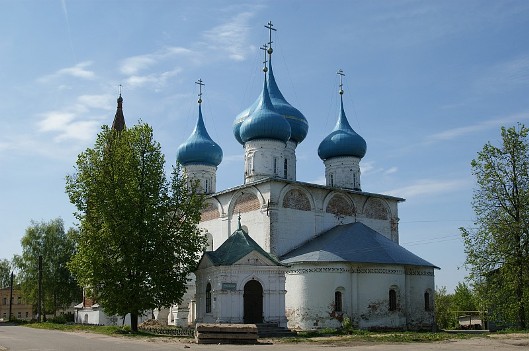

The Annunciation Cathedral (Blagoveshchensky Sobor) stands as the principal Orthodox church and a defining landmark in the historic town of Gorokhovets, located in Russia's Vladimir Oblast. Situated in the town's central square within the former trading quarter on the south bank of the Klyazma River, it exemplifies the architectural prosperity of the late 17th and early 18th centuries, when local merchant wealth funded a surge in stone construction across the region. Built primarily between the late 1690s and 1700, the cathedral was consecrated in 1700, marking the culmination of Gorokhovets' transformation into a vibrant merchant center after periods of recovery from invasions and civil unrest.
Gorokhovets itself dates back to around 1168, founded as a fortified
outpost under Grand Prince Andrey Bogolyubsky to guard the eastern
borders of the Vladimir-Suzdal principality. The town endured
significant hardships, including the Mongol invasion of 1239, Tatar
raids in 1539, and involvement in the Time of Troubles (early 17th
century), which included battles against Polish-Lithuanian forces. By
the mid-17th century, stability returned, bolstered by trade along the
Volga River and local crafts such as leatherworking. This economic
upswing, driven by wealthy merchants like the Ershov, Shiryaev, and
Sapozhnikov families, enabled the construction of grand stone
structures, including monasteries, churches, and merchant houses.
The
Annunciation Cathedral emerged as part of this building boom, serving as
the town's main place of worship and a symbol of communal piety and
prosperity. Dedicated to the Annunciation of the Theotokos (the biblical
event where the Archangel Gabriel announces to the Virgin Mary that she
will bear Jesus), it reflects the deep Orthodox traditions of the era.
During the Soviet period, like many Russian churches, it faced
desecration and repurposing—churches in Gorokhovets were often converted
into clubs or storage facilities—but the cathedral survived relatively
intact. Post-Soviet restoration efforts have revived it as an active
religious site and a key element in Gorokhovets' push for UNESCO World
Heritage status, recognized for its preserved 17th-century ensemble. The
town's inclusion in Russia's list of historical settlements underscores
the cathedral's role in illustrating a pivotal stage in Russian urban
and architectural development.
The cathedral embodies traditional Russian Orthodox architecture of
the period, characterized by its whitewashed stone walls that give it a
graceful, luminous appearance against the verdant landscape of the
Klyazma River valley. Constructed in a fortress-like style common to
merchant-funded buildings in Gorokhovets, it features robust masonry
that echoes the defensive aesthetics of earlier Russian structures while
incorporating decorative elements typical of the late Muscovite period.
At its core, the cathedral is a five-domed edifice, with the central
dome symbolizing Christ and the four surrounding ones representing the
Evangelists—a standard motif in Russian church design. The domes are
likely gilded or painted in vibrant colors, crowning the structure with
a sense of heavenly elevation. The exterior is adorned with kokoshniki
(semi-circular decorative arches) and corbel arches, blending influences
from Pskov and Moscow architectural schools, though adapted to local
tastes. (Note: While detailed blueprints are scarce in English sources,
comparisons to contemporary churches suggest these features.) The facade
includes intricate brickwork patterns, pilasters, and arched windows
that provide a rhythmic visual harmony. An attached bell tower, possibly
replicating wooden architectural forms with its tiered design, adds
vertical emphasis and serves practical purposes for calling worshippers.
Internally, the layout follows a cross-in-square plan, common in
Orthodox cathedrals, with a central nave leading to an altar area
screened by an iconostasis. Frescoes and icons likely adorn the walls,
depicting scenes from the Annunciation, lives of saints, and biblical
narratives, though specific artworks from the 1700s may have been
restored or replaced over time. The interior spaces are intimate yet
grand, designed for both communal services and private merchant
devotions. A refectory or walkway may connect to adjacent structures,
facilitating processions and reflecting the ensemble's integration with
nearby merchant houses and monasteries.
Domes and Roofline: The multi-domed silhouette dominates the town's
skyline, visible from afar, including from Puzhalova (Frightful) Hill,
where legend holds a heavenly warrior apparition once repelled invaders.
Bell Tower: Integrated or adjacent, it features elements mimicking
wooden architecture, such as tiered octagonal sections, enhancing
acoustic resonance across the river valley.
Iconostasis and Frescoes:
As the focal point, the iconostasis would house venerated icons,
possibly including local relics or copies of famous Russian icons like
the Vladimir Mother of God, tying into nearby monasteries.
Surroundings: The cathedral anchors the central square, surrounded by
17th-century merchant chambers (e.g., Ershov's House from the 1660s) and
overlooks the river, creating a cohesive historical panorama.
Beyond its religious function, the Annunciation Cathedral symbolizes
Gorokhovets' resilience and merchant-driven golden age, standing as one
of the few preserved examples of pre-Petrine Russian civil and
ecclesiastical architecture untouched by Western influences. It
contributes to the town's unique status, with seven of Russia's twenty
surviving 17th-century stone merchant houses nearby, forming an ensemble
that highlights the interplay between trade, faith, and urban planning.
In 2010, Gorokhovets retained its designation as a Historical City of
Russia, partly due to sites like this cathedral. Efforts toward UNESCO
listing emphasize its value as an "outstanding example of a type of
building... illustrating an important stage in the history of mankind."
Today, the cathedral remains an active Russian Orthodox site, hosting
services, festivals, and attracting tourists interested in Russia's
provincial heritage. Its location amid wooden modern-style houses from
the 19th-20th centuries and natural landmarks like Bald Mountain adds to
its appeal as a window into unspoiled Russian history. Visitors often
combine it with nearby attractions, such as the Trinity-St. Nicholas
Monastery on Puzhalova Hill or the Znamensky Monastery across the river,
for a comprehensive exploration of Gorokhovets' fragile yet enduring
beauty.